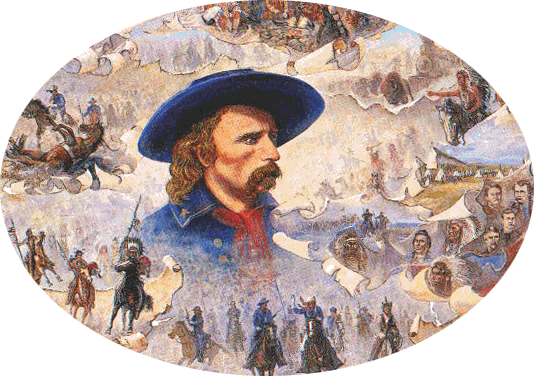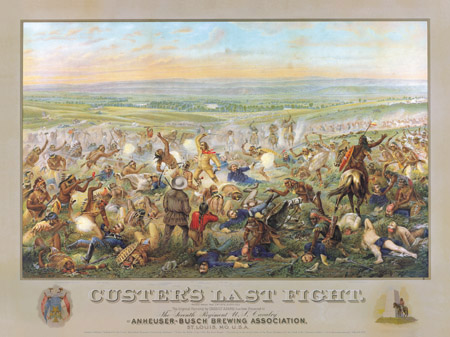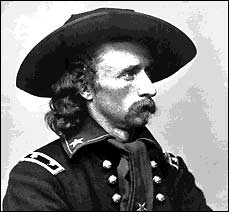

|
|
|
Among the Cheyenne he was known as "Long Hair." The Arikara knew
him as "Creeping Panther Who comes in the Night" and the Crow
called him "Son of the Morning Star Who Attacks at Dawn." George
Armstrong Custer was known as many things throughout his life. He was
known as a hero, and enemy, an army officer, and a loving husband. The
best thing he was known for was The Battle of Little Big Horn or
"Custer's Last Stand" |
|
|
Custer was born in New Rumley, Ohio on December 5, 1839. He grew up on a
farm with his parents, Emanuel and Maria. Armstrong had three brothers and
one sister. He graduated from Alfred Stubbins' Young Men's Academy in
Monroe, in 1855. Custer then moved back to Ohio to teach at Beach Point
School in Harrison. In 1856, he petitioned to Ohio Congressman, John
Bingham, for an appointment to West Point. In 1857, he enrolled in West
Point. After four years of going to West Point, he graduated at the bottom
of his class. Two days after graduation, while on duty as
officer-of-the-guard, he failed to stop a fight between two cadets. Custer
was court-martialed for this, but was saved punishment because of the
outbreak of the Civil War and the urgent need for officers. |
|
|
At age 23, he was the youngest general in the Union Army. Custer did
unexpectedly well in the Civil War. He reported for duty at Washington.
General Winfield Scott gave him dispatches to carry to General Irwin
McDowell, then in command of the Potomac. Custer was assigned to duty as
Lieutenant of the Fifth Calvary. Many who served with the "Boy
General" admired him. Many hated him and called him "Glory
Hunter." On the day of his arrival at Front Tile, he participated in
the First Battle of Bull Run. Custer also served, with distinction, in the
Virginia and Gettysburg campaign. |
|
|
Although his units suffered enormously high casualty rates
--even by the standards of the Civil War-- his fearless aggression in
battle earned him the respect of his Commanding Generals, and increasingly
put him in the public eye. His Calvary Units played a critical role in
forcing the retreat of Confederate Robert E. Lee's forces. In gratitude,
General Philip Sheridan purchased and made a gift of the Appomattox
surrender table to Custer and his wife, Elizabeth Bacon Custer. (Married
February 9,1864 at Presbyterian Church in Monroe.) He also received a
battlefield promotion to General, and personally accepted the White Flag
of Surrender from General Robert E. Lee at Appomattox. |
|
|
After the war he was stripped of his battlefield
commission, and returned to the regular Army as Captain. George Armstrong
Custer was promoted to Lieutenant Colonel of the Seventh Calvary. This
began his career as an Indian fighter. In 1867, Custer was court-martialed
on charges for leaving his command post (to visit his wife), and for
shooting deserters on the spot and not letting them be treated. He was
guilty on both charges, and was suspended for a year from the army without
pay. Ten months later he was later he was reinstated by General Sheridan
to lead the Campaign against Southern Cheyenne in Oklahoma Territory. |
| |
|
Custer redeemed himself on November 27, 1868. He raided a Southern
Cheyenne tribe. (Black Kettle's) This massacre was called the Battle of
Washita. It took place along the banks of the Washita River. The Cheyenne
had no warning about this battle. 103 Cheyenne were killed. (Mostly women
and children) Custer ordered all Cheyenne pets to be slaughtered, (Over
800 were killed) and all possessions to be burned. |
| |
|
In 1876 the Army planned to round up the Sioux and Cheyenne Indians onto
reservations. Custer's regiment joined the expedition, commanded by
General Alfred H. Terry. Custer's troops were sent west. Advancing much
more quickly than ordered to, he came upon an Indian village in the valley
of Little Big Horn River on June 25, 1876. On the verge of what seemed
like a victory for both the United States and himself, he ordered and
immediate attack on the village. (He believed that there were only 1,000
Indians. There was really 2,500-5,000 Lakota, Cheyenne, and Arapaho.) He
divided his regiment into three columns-- one under Captain Frederick
Benteen, one under Major Marcus A. Reno, and one under himself. Benteen
was ordered off to the left to search the mountain valley for Indians.
Reno was to charge ahead across the river and attack the Indian village.
Advancing into the bluffs on the right, Custer's column was going to
attack the village from the rear. His whole column, including himself, was
killed that day. |
 |
| |
|
Reno fought a bloody battle in the valley then retreated across the river
and up the bluffs. Benteen's column joined them. they held off the Indians
until Terry arrived on Jun 27,1876. |
| |
|
The Battle of Little Big Horn was one of the greatest fiascos the U.S.
Army have ever encountered. Nobody will ever forget that horrific day when
Custer was killed. June 25,1876 is one of the most memorable dates in
history. |
| |
When Walt Whitman found out about the Battle of Little Big Horn he wrote
this poem:
|
From Far Dakota's Canons
 |
|
|
| |
FROM far
Dakota's caņons,
Lands of the wild ravine, the dusky Sioux, the lonesome
stretch, the
silence,
Haply to-day a mournful wail, haply a trumpet-note for
heroes.
The battle-bulletin,
The Indian ambuscade, the craft, the fatal environment,
The cavalry companies fighting to the last in sternest
heroism,
In the midst of their little circle, with their
slaughter'd horses
for breastworks,
The fall of Custer and all his officers and men.
Continues yet the old, old legend of our race,
The loftiest of life upheld by death, 10
The ancient banner perfectly maintain'd,
O lesson opportune, O how I welcome thee!
As sitting in dark days,
Lone, sulky, through the time's thick murk looking in vain
for light,
for hope,
From unsuspected parts a fierce and momentary proof,
(The sun there at the centre though conceal'd,
Electric life forever at the centre,)
Breaks forth a lightning flash.
Thou of the tawny flowing hair in battle,
I erewhile saw, with erect head, pressing ever in front,
bearing a
bright sword in thy hand, 20
Now ending well in death the splendid fever of thy deeds,
(I bring no dirge for it or thee, I bring a glad triumphal
sonnet,)
Desperate and glorious, aye in defeat most desperate, most
glorious,
After thy many battles in which never yielding up a gun or
a color
Leaving behind thee a memory sweet to soldiers,
Thou yieldest up thyself.
Walt Whitman
|
|
|
| |
| |
| Bibliography |
| |
| "George
Armstrong Custer." <http://www.pbs.org/weta/thewest/people/a_c/custer.htm>
(5-17-05) |
| |
| Walt Whitman. "Far
From Dakota's Canon." <http://www.poemhunter.com/p/m/poem.asp?poet=3108&poem=15771>
(5-17-05) |
| |
| George Armstrong
Custer. <http://www.jalapenocafe.com/portfolio/fame_fortune/bio.html>
(9-17-05) |
| |
| Brief Sketch of Custer's
Life. <http://www.pages.prodigy.com/custer/bio.htm>
(9-17-05) |
| |
| George A. Custer and the
Battle of Little Big Horn. <http://www.hanksville.org/daniel/misc/Custer.html>
(5-17-05) |
| |
| "George Armstrong
Custer." <http://www.georgearmstrongcuster.com/>
(5-17-05) |
| |
| Field Enterprises
Educational Corporation. U.S.A. 1973 |
| |
| Movie: Sun of the
Morning Star |
| |
| Pictures |
| |
| "Custer Battlefield
Museum" <http://www.custermuseum.org>
Battlefield (5-17-05) |
| |
| "George Armstrong
Custer" <http://www.pbs.org/weta/thewest/people/a_c/custer.htm>
Custer's side (5-17-05) |
| |
| "General George A.
Custer" <http://www.garryowen.com/>
background (5-17-05) |
| |
| "Google
Images" <http://mariah.stonemarche.org/livhis/custer.gif>
(5-17-05) |
| |
| |
| Angelique Flinn |
| 8th American History |
| 2005 Project |
| |
| |
| |
| |
| |


